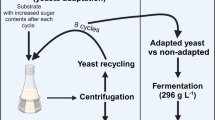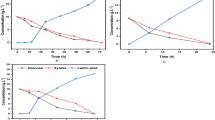Abstract
The yeast Dekkera bruxellensis has been regarded as a contamination problem in industrial ethanol production because it can replace the originally inoculated Saccharomyces cerevisiae strains. The present study deals with the influence of nitrate on the relative competitiveness of D. bruxellensis and S. cerevisiae in sugar cane ethanol fermentations. The industrial strain D. bruxellensis GDB 248 showed higher growth rates than S. cerevisiae JP1 strain in mixed ammonia/nitrate media, and nitrate assimilation genes were only slightly repressed by ammonia. These characteristics rendered D. bruxellensis cells with an ability to overcome S. cerevisiae populations in both synthetic medium and in sugar cane juice. The results were corroborated by data from industrial fermentations that showed a correlation between high nitrate concentrations and high D. bruxellensis cell counts. Moreover, the presence of nitrate increased fermentation efficiency of D. bruxellensis cells in anaerobic conditions, which may explain the maintenance of ethanol production in the presence of D. bruxellensis in industrial processes. The presence of high levels of nitrate in sugar cane juice may be due to its inefficient conversion by plant metabolism in certain soil types and could explain the periodical episodes of D. bruxellensis colonization of Brazilian ethanol plants.




Similar content being viewed by others
References
Abbott DA, Hynes SH, Ingledew WM (2005) Growth rates of Dekkera/Brettanomyces yeasts hinder their ability to compete with Saccharomyces cerevisiae in batch corn mash fermentations. Appl Microbiol Biotechnol 66:641–647
Avila J, Gonzalez C, Brito N, Siverio JM (1998) Clustering of the YNA1 gene encoding a Zn(II)2Cys6 transcriptional factor in the yeast Hansenula polymorpha with the nitrate assimilation genes YNT1, YNI1 and YNR1, and its involvement in their transcriptional activation. Biochem J 335:647–652
Barnett JA, Entian K-D (2005) A history of research on yeast: regulation of sugar metabolism. Yeast 22:835–894
Basílio ACM, Araújo PRL, Morais JOF, Silva-Filho EA, Morais MA Jr, Simões DA (2008) Detection and identification of wild yeast contaminants of the industrial fuel ethanol fermentation process. Curr Microbiol 56:322–326
Blomqvist J, Eberhard T, Schnürer J, Passoth V (2010) Fermentation characteristics of Dekkera bruxellensis strains. Appl Microbiol Biotechnol 87(4):1487–1497. doi:10.1007/s00253-010-2619-y
Böer E, Schröter A, Bode R, Piontek M, Kunze G (2009) Characterization and expression analysis of a gene cluster for nitrate assimilation from the yeast Arxula adeninivorans. Yeast 26:83–93
Burger M, Jackson LE (2004) Plant and microbial nitrogen use and turnover: rapid conversion of nitrate to ammonium in soil with roots. Plant Soil 266:289–301
Conterno L, Joseph CML, Arvik TJ, Henick-Kling T, Bisson LF (2006) Genetic and physiological characterization of Brettanomyces bruxellensis strains isolated from wines. Am J Enol Vitic 57:139–147
Garcia-Lugo P, Gonzalez C, Perdomo G, Brito N, Avila J, de la Rosa JM, Siverio JM (2000) Cloning, sequencing, and expression of HaYNR1 and HaYNI1, encoding nitrate and nitrite reductases in the yeast Hansenula anômala. Yeast 16:1099–1105
Hirel B, Le Gouis J, Ney B, Gallais A (2007) The challenge of improving nitrogen use efficiency in crop plants: towards a more central role for genetic variability and quantitative genetics within integrated approaches. J Exp Bot 58:2369–2387
Kaiser BN, Gridley KL, Brady JN, Phillips T, Tyerman SD (2005) The role of molybdenum in agriculture plant production. Ann Bot 96:745–754
Liberal ATS, Basílio ACM, Resende AM, Brasileiro BTRV, Silva-Filho EA, Morais JOF, Simões DA, Morais MA Jr (2007) Identification of Dekkera bruxellensis as a major contaminant yeast in continuous fuel ethanol fermentation. J Appl Microbiol 102:538–547
Loureiro V, Malfeito-Ferreira M (2003) Spoilage yeasts in the wine industry. Int J Food Microbiol 86:23–50
Magasanik B (2003) Ammonia assimilation by Saccharomyces cerevisiae. Eukaryot Cell 2:827–829
Medawar W, Strehaiano P, Delia ML (2003) Yeast growth: lag phase modeling in alcoholic media. Food Microbiol 20:527–532
Nardi T, Remize F, Alexandre H (2010) Adaptation of yeasts Saccharomyces cerevisiae and Brettanomyces bruxellensis to winemaking condition: a comparative study of stress gene expression. Appl Microbiol Biotechnol 88:925–937
Passoth V, Blomqvist J, Schnürer J (2007) Dekkera bruxellensis and Lactobacillus vini form a stable ethanol-producing consortium in a commercial alcohol production process. Appl Environ Microbiol 73:4354–4356
Silva-Filho EA, Melo HF, Antunes DF, Dos Santos SKB, Resende MA, Simões DA, Morais MA Jr (2005) Isolation by genetics and physiological characteristics of a fuel-ethanol fermentative Saccharomyces cerevisiae strain with potential for genetic manipulation. J Ind Microbiol Biotechnol 32:481–486
Siverio JM (2002) Assimilation of nitrate by yeasts. FEMS Microbiol Rev 26:277–284
Vandesompele J, De Preter K, Pattyn F, Poppe B, Van Roy N, De Paepe A, Speleman F (2002) Accurate normalization of real-time quantitative RT-PCR data by geometric averaging of multiple internal control genes. Genome Biol 3:00341
Woolfit M, Rozpedowska E, Piskur J, Wolfe KH (2007) Genome survey sequencing of the wine spoilage yeast Dekkera (Brettanomyces) bruxellensis. Eukaryot Cell 6:721–733
Acknowledgments
The authors thank to Mr. Carlos Farias (distillery Miriri S.A.) for providing soil and cane juice analysis, Prof. Volkmar Passoth (Swedish University of Agricultural Sciences) and Dr. David Bousfield (Ganesha Associates, Cambridge UK) for their kind comments on the manuscript preparation and to the companies Genetech Bioprodutividade Ltd (Recife, Brazil), Japungu Agroindustrial S.A. (Santa Rita, Brazil) and Miriri S.A. (Santa Rita, Brazil) for their kind assistance with the industrial samples. This work was supported by grants and scholarships from the Brazilian funding agencies Conselho Nacional de Desenvolvimento Científico e Tecnológico (CNPq), Coordenação de Aperfeiçoamento de Pessoal de Nível Superior (CAPES) and Fundação de Amparo a Ciência e Tecnologia do Estado de Pernambuco (FACEPE).
Author information
Authors and Affiliations
Corresponding author
Rights and permissions
About this article
Cite this article
de Barros Pita, W., Leite, F.C.B., de Souza Liberal, A.T. et al. The ability to use nitrate confers advantage to Dekkera bruxellensis over S. cerevisiae and can explain its adaptation to industrial fermentation processes. Antonie van Leeuwenhoek 100, 99–107 (2011). https://doi.org/10.1007/s10482-011-9568-z
Received:
Accepted:
Published:
Issue Date:
DOI: https://doi.org/10.1007/s10482-011-9568-z




